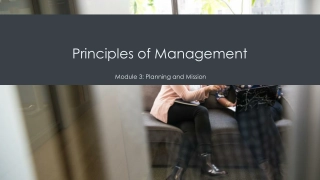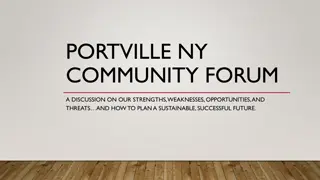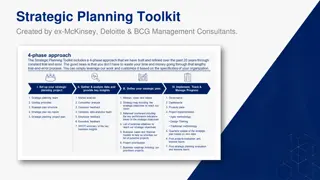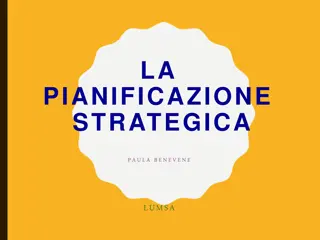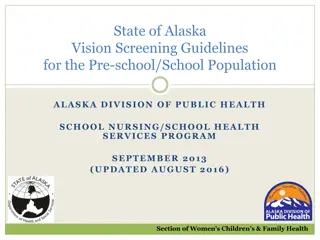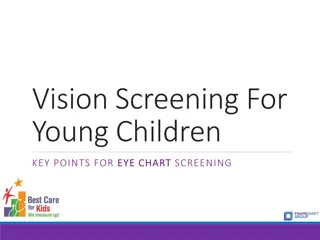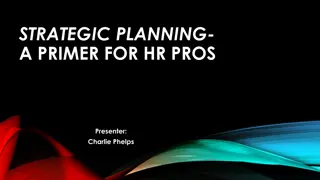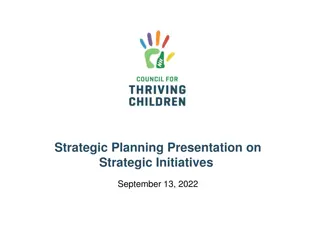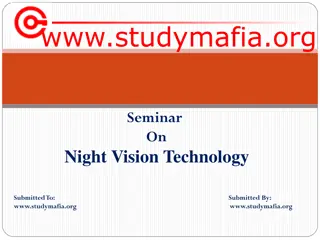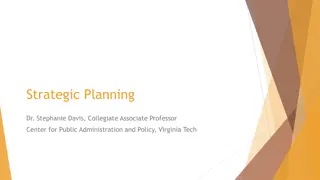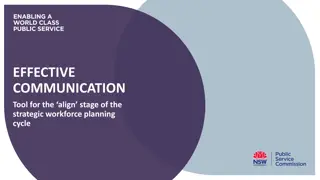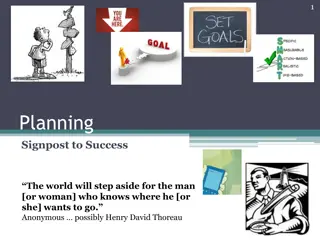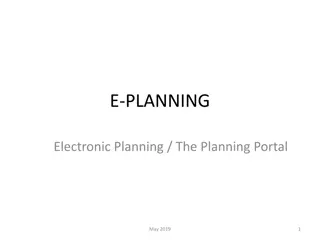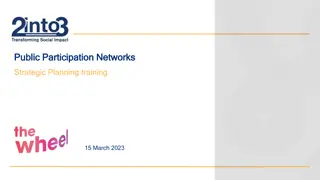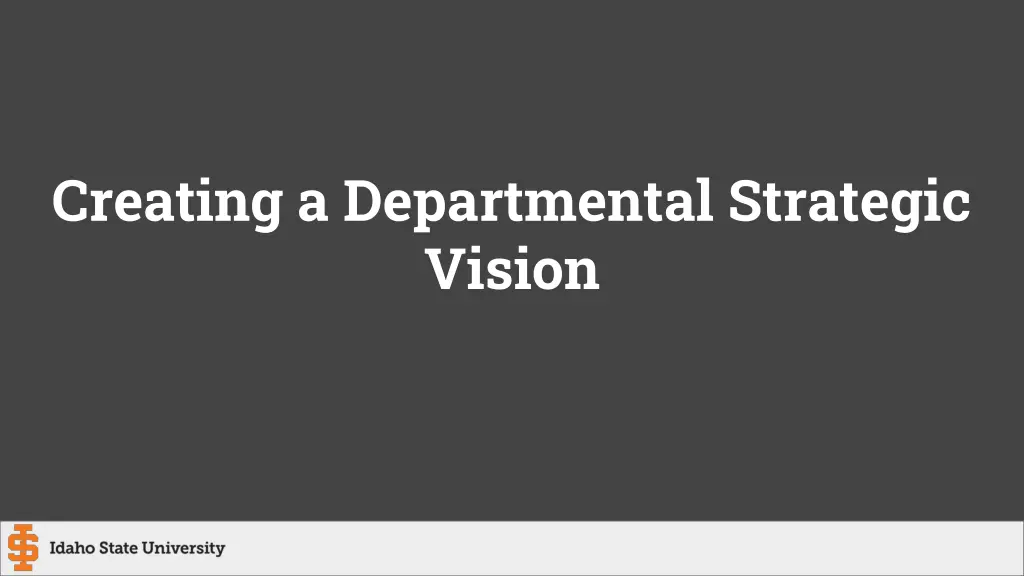
Crafting a Data-Informed Strategic Vision for Departmental Excellence
Learn how to develop a data-informed strategic vision for your department by conducting analysis, setting goals, and formulating action plans. Utilize templates, timelines, and support resources to create a forward-thinking vision that aligns with trends and stakeholder needs. Engage your work group effectively to draft and refine the vision document for submission.
Download Presentation

Please find below an Image/Link to download the presentation.
The content on the website is provided AS IS for your information and personal use only. It may not be sold, licensed, or shared on other websites without obtaining consent from the author. If you encounter any issues during the download, it is possible that the publisher has removed the file from their server.
You are allowed to download the files provided on this website for personal or commercial use, subject to the condition that they are used lawfully. All files are the property of their respective owners.
The content on the website is provided AS IS for your information and personal use only. It may not be sold, licensed, or shared on other websites without obtaining consent from the author.
E N D
Presentation Transcript
Steps/Timeline January --Conduct unit overview of data from Program Analytics Dashboard and other relevant sources (see Template ? s 2&3) February --Conduct analysis of data in context of disciplinary innovations and issues related to affordability (see Template ? s 4&5) March --Identify goals and objectives that will form Strategic Vision March --Identify targeted Action Plans April --Write, revise, and submit data-informed 3-5 year Strategic Vision to Dean
Links and Support Resources Data-Informed Strategic Vision Template ISU Strategic Plan OAR Philosophy OAR Personnel Hiring Process Link for Faculty Position Hiring for Academic Units Link for Staff Position Hiring for Academic Units
Unit Roles and Responsibilities Identify your work group(s) the workgroup can be the full department or you can create subcommittees to address different aspects of the vision development. Set timelines and determine when each question included in the Template will be discussed by the department. Discuss each section of the template as a department. Based on these discussions, the chair should draft the 2 page visioning document required. Chair should present the draft to the department for discussion/revision before taking it to the Dean for additional discussion.
Creating a Data-Informed Strategic Vision
Data-Informed Strategic Vision A Data-Informed Strategic Vision expresses a realistically achievable if aspirational future that describes what we believe we are primed to become based on such things as: longitudinal trends, student interest and demand for our programming, current financial or other resources, student needs, disciplinary trends, existing or potential internal or external partnerships, etc. It should be less a wish-list and more an exercise in data-responsive direction-setting. Plans to create smaller, more focused departments are just as legitimate and valuable as those targeting significant growth the key is creating a plan that responds to and is justified by the trends observed in the various areas under consideration.
Qualities of a Good Strategic Vision Qualities of a Good Strategic Vision Document: Succinct Data-Responsive Forward thinking Includes clear targets Realistic Demonstrates an awareness of affordability/efficiency
Creating a Strategic Vision Statement (see Strategic Vision Template for additional details related to the below) Do This Then This Look at your longitudinal trends in the Analytics Dashboard Gather and share information related to workforce demand, external partners and student interest Gather and share information related to disciplinary innovations that may be relevant to your program. Discuss the significance of these trends Discuss the significance of these in light of the previous data from the Analytics Dashboard Discuss how incorporating disciplinary innovations into curriculum, faculty body, research profiles might shape the unit s future in light of the above trends or information. (Possibly conduct SOAR)
Creating a Strategic Vision Statement (Con t) Do This Then This Drawing on the above conversations, begin to synthesize a data- responsive vision that aligns with our institutional strategic plan and that spans a 3-5 year window. Include discrete actions and be mindful of issues related to affordability. Share this draft with all faculty in the department, revise (if necessary). Write a draft document that encapsulates the data-responsive vision articulated in response to the above, articulating discrete actions to be taken and demonstrating an awareness of affordability and financial impact. Chair should bring this document to the Dean for additional conversation.
SOAR Exercise Strengths, Opportunities, Aspirations, Results (Some units may find it helpful to conduct a SOAR as part of their analysis in order to invite faculty articulate their thoughts around the data trends and other factors under discussion) Strengths Opportunities What we do well, along with our key assets, resources, capabilities, and accomplishments Internal and external circumstances that we can leverage for success Aspirations Results A shared vision that builds on current strengths, provides inspiration, and challenges the status quo Tangible outcomes and measures that demonstrate we are achieving our mission and goals
Vision vs. Targeted Actions Vision is: Targeted Actions are: Focused on the end outcomes (where we want to land ). Describes direction and big picture. The specific means you will use to achieve these ends. The clear actions/steps to get us there. Focuses holistically on the long term. Shorter term actions to be taken. States general intentions. Oriented to achieving specific outcomes. Is realistically aspirational. Concrete.
Identifying Targeted Action Plans Action plans create specific roadmaps for accomplishing your goals and objectives. Shorter term Action-focused Specific tasks Timeline, milestones Defined outcomes/results Connected to resources
Example Vision Statement Over the course of the last 5 years, Program A has seen a significant increase in the average numbers of students enrolling in the courses we offer related to our interdisciplinary certificate program (up by XX), but we have also seen a modest decline in the enrollments in our major that appears to now be stabilizing (decreased by XX). The overall decline in our majors is likely a result of the fact that they typically enter the workforce as XX, and the current data available from the Bureau of Labor and Statistics shows that the U.S. labor market is approaching saturation for individuals in this field. In short, job openings and demand are declining across the nation and therefore, for the remainder of this decade, it is logical to believe that we are not likely to see an increase in student demand. This is also likely the reason why our faculty are reporting fewer and fewer external grant opportunities being made available to researchers in our field. Given the strength of our certificate enrollments and the stabilizing of our major at somewhat lower than historical levels, the department believes it is appropriate to respond by analyzing how we might deliver more sections related to the certificate curriculum. Our ability to deliver more sections for the certificate may require us to look at the breadth of curricular requirements currently in our major. It is unknown whether or not we would be able to increase certificate-supporting sections without overly impacting our delivery of the major which needs to remain strong to serve the cohorts we are anticipating. Nevertheless, we believe that recent disciplinary innovations may also align with some streamlining of our major curriculum and allow us to make meaningful, if modest, changes to the major. We believe that this aligns with our institutional mission to Increase student access, opportunity, and retention, as our certificate offerings have proven significantly impactful in helping students develop skills in XX that are essential for them to succeed in their chosen careers.
Example Targeted Actions Assess certificate demand to ensure that additional sections will prove helpful to our students. Assess departmental curriculum in light of shifting disciplinary emphases in XX, to ascertain whether these shifts can align with revision of the major so as to allow the department to increase certificate-supporting sections in XX from 10 to 15 sections per year. The department anticipates that it is likely that we will have at least 1 tenure track faculty opening and either 1 instructor or 1 additional tenure track faculty opening emerge in the course of the next 5 years. In alignment with the above, we anticipate the need to hire one tenure-track faculty member with a research focus in XX, and one instructor focused on teaching certificate-oriented and lower division courses. We believe that hiring the tenure-track faculty member is the highest priority and may allow us to more realistically attend to the disciplinary innovations referenced above. Current budget costs associated with the openings we are anticipating would be sufficient to cover the replacement costs of the faculty we would anticipate hiring, so we believe these actions would be budget neutral if not allow for a modest cost savings. Given the disciplinary innovations mentioned, we also believe that we would benefit from expanding our current program advisory board to include an individual with this type of experience.

